Lessico
Falaropodi
In greco phálaros significa chiazzato di bianco, per cui i Falaropodi dovrebbero avere i piedi di questo colore. Nei Falaropodi, la cui lunghezza totale è pari a 18-25 cm, la parte inferiore del piumaggio è molto folta, i tarsi sono compressi lateralmente, le dita sono fornite di lembi o lobi cutanei (adattamento al nuoto). La livrea di riposo (autunno-inverno) è superiormente grigia e inferiormente bianca, senza differenze fra i due sessi; le femmine adorne della variopinta livrea nuziale sono più grosse e più splendidamente colorate dei maschi.
Vi sono 3 specie: il Falaropo dal becco largo (Phalaropus fulicarius) cova nelle tundre artiche del Vecchio e del Nuovo Mondo; il Falaropo dal becco sottile (Phalaropus lobatus) cova nella zona subartica; il Falaropo di Wilson (Phalaropus tricolor) cova nell'ovest del Canada e degli Stati Uniti. Le prime due specie svernano sul mare e si nutrono allora dei crostacei planctonici; la specie americana trascorre l'inverno sulle rive delle paludi del Sudamerica.
I Falaropodi nuotano, come i Gabbiani, sulle onde, sono quindi « leggeri come sugheri »; sovente fanno cenni col capo e vibrano colpi di becco nell'acqua. Nell'acqua bassa girano su se stessi a gran velocità per raccogliere dal vortice così ottenuto il plancton (microscopici esseri viventi marini). Talvolta accompagnano le loro rotazioni con violenti colpi d'ala sull'acqua.
L'arrivo delle femmine nel territorio di incubazione precede spesso di alcuni giorni quello dei maschi. Le coppie si formano nel modo seguente: una femmina rimane costantemente nelle vicinanze di un determinato compagno e respinge con un atteggiamento minaccioso, e se necessario con aggressioni a colpi di becco, le altre femmine che tentano di avvicinarsi. Come avviene in molti altri gruppi di Uccelli, anche tra i Falaropi sono le femmine a scegliere il proprio compagno; la loro capacità di richiamo dipende anche da un piumaggio più variopinto di quello dei maschi. Gli Uccelli, per costruire il nido, formano una cunetta comprimendo il petto contro il suolo, e facendo poi dei movimenti rotatori. Solo dopo che la compagna ha deposto le uova il maschio imbottisce la cunetta con piccoli frammenti vegetali. La variopinta livrea nuziale della femmina e la sua indole bellicosa sono causate da un'abbondante secrezione nelle ovaie di ormoni sessuali di tipo maschile. Le macchie d'incubazione invece, che compaiono solo nei maschi, vengono formate sotto l'influsso della prolattina, un ormone secreto dal lobo anteriore dell'ipofisi che provoca nei Mammiferi, durante il periodo dell'allattamento, la secrezione lattea.
Nei Falaropodi la maggior parte delle femmine abbandona il nido già durante la cova. Pertanto in genere i piccoli vengono curati solo dal maschio fino a quando non sono in grado di volare; talvolta però anche la femmina si occupa di loro. Poiché all'epoca dell'incubazione i maschi sono in soprannumero, si presume che le femmine vivano in poliandria. Testimonianze supplementari a sostegno di questa opinione non sono state ancora prodotte.
Bernhard
Grzimek
Vita degli animali - 1974
Falaropo
beccolargo
Phalaropus fulicarius
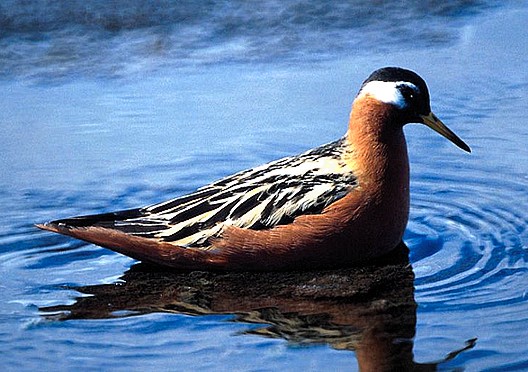
Il falaropo beccolargo (Phalaropus fulicarius, Linnaeus 1758) è un uccello della famiglia degli Scolopacidae dell'ordine dei Charadriiformes. Il falaropo beccolargo è un uccello con un leggero dicromatismo sessuale, ma è la femmina ad avere i colori più sgargianti, non il maschio, come accade nella maggioranza dei casi. La femmina ha un piumaggio marrone-rossastro sul collo e su tutta la parte inferiore del corpo; la coda è grigia, il capo nero con due bende bianche attorno agli occhi; il dorso è nero bordato color camoscio; il becco è giallo con la punta nera, il sottoala bianco e grigio. I colori maschili sono simili ma più scialbi, in cui è il grigio a predominare. Il manto invernale è più discreto: grigio superiormente e bianco candido inferiormente; il capo è bianco con una spruzzata di grigio in cima e una particolare virgola attorno agli occhi. Non è un uccello di grandi dimensioni, raggiunge al massimo i 22 centimetri, con un peso che si aggira tra i 40 e gli 80 grammi. L'apertura alare misura 37-40 centimetri.
È un uccello migratore: passa l'estate nelle regioni circumpolari tra l'estremo Nord America, la Groenlandia, l'Islanda e la Russia. In inverno migra a sud: lo si incontra sulle coste cilene e argentine, su quelle dell'Africa occidentale, specialmente quelle della Mauritania, dell'Angola, della Namibia e del Sudafrica. Di passo lo si osserva anche nel centro Europa (in Italia non è raro), ai Caraibi o in zone dell'Africa non costiere. Il falaropo beccolargo passa la stagione estiva sul mare delle coste artiche o presso stagni fangosi della tundra artica. In inverno diventa fortemente pelagico e si allontana parecchio dalle coste, anche per lunghi periodi.
Si ciba prevalentemente di crostacei e altri piccoli animali che trova in superficie, ma all'occorrenza riesce a procurarsi il cibo con un curioso espediente: ruotando su se stesso crea dei piccoli mulinelli nell'acqua, così coloro che vi incappano vengo portati in superficie divenendo facili prede del falaropo.
Durante il periodo riproduttivo, i classici ruoli di maschio e femmina sono quasi totalmente invertiti. È la femmina che prende l'iniziativa e si esibisce per attirare il maschio (se la popolazione maschile eccede in numero, la femmina può accoppiarsi anche con due maschi). Una volta formata la coppia, la femmina depone dalle tre alle quattro uova verdi pallide macchiate di bruno, in un nido nascosto nella vegetazione paludosa della tundra. L'incubazione dura circa 19 giorni, durante i quali è il maschio a prendersi cura delle uova. Successivamente sarà ancora il maschio a badare ai piccoli fino a completo svezzamento.
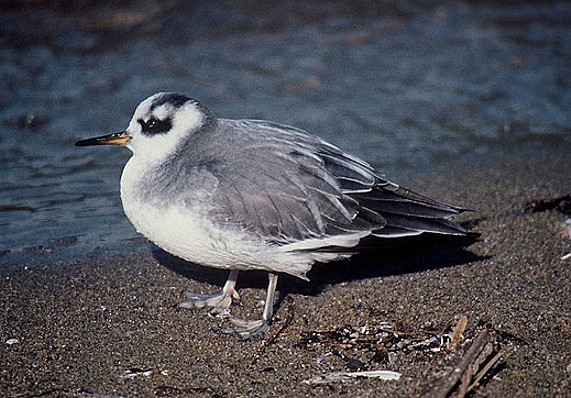
Red
Phalarope
Phalaropus fulicarius
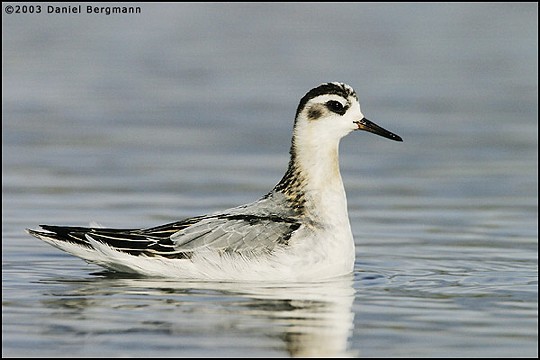
Juvenile plumage
The Red Phalarope (called Grey Phalarope in Europe), Phalaropus fulicarius, is a small wader. This phalarope breeds in the Arctic regions of North America and Eurasia. It is migratory, and, unusually for a wader, migrating mainly on oceanic routes and wintering at sea on tropical oceans. Red Phalarope is about 21 cm (8 inches) in length, with lobed toes and a straight bill, somewhat thicker than that of Red-necked Phalarope. The breeding female is predominantly dark brown and black above, with red underparts and white cheek patches. The bill is yellow, tipped black. The breeding male is a duller version of the female. Young birds are light grey and brown above, with buff underparts and a dark patch through the eye. In winter, the plumage is essentially grey above and white below, but the black eyepatch is always present. The bill is black in winter. Their call is a short beek.
The typical avian sex roles are reversed in the three phalarope species. Females are larger and more brightly coloured than males. The females pursue males, compete for nesting territory, and will aggressively defend their nests and chosen mates. Once the females lay their olive-brown eggs, they begin their southward migration, leaving the males to incubate the eggs and care for the young. Three to six eggs are laid in a ground nest near water. The young mainly feed themselves and are able to fly within 18 days of birth.
When feeding, a Red Phalarope will often swim in a small, rapid circle, forming a small whirlpool. This behaviour is thought to aid feeding by raising food from the bottom of shallow water. The bird will reach into the outskirts of the vortex with its bill, plucking small insects or crustaceans caught up therein. They sometimes fly up to catch insects in flight. On the open ocean, they are found in areas where converging ocean currents produce upwellings and are often found near groups of whales. Outside of the nesting season, they often travel in flocks.
This species is often very tame and approachable. The Red Phalarope is one of the species to which the Agreement on the Conservation of African-Eurasian Migratory Waterbirds (AEWA) applies.
Falaropo
beccosottile
Phalaropus lobatus
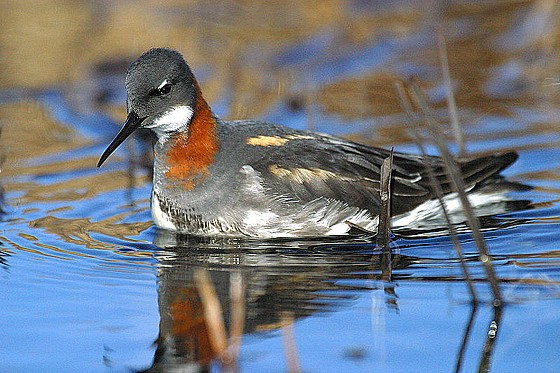
Il falaropo beccosottile (Phalaropus lobatus, Linnaeus 1758) è un uccello della famiglia degli Scolopacidae dell'ordine dei Charadriiformes. Phalaropus lobatus non ha sottospecie, è monotipico.
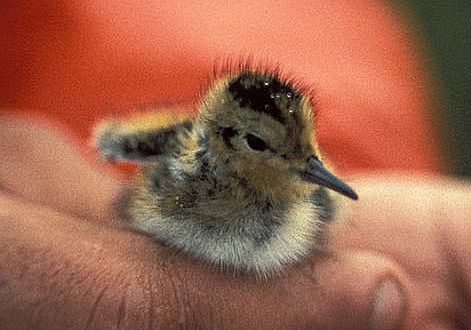
Red-necked
Phalarope
Phalaropus lobatus
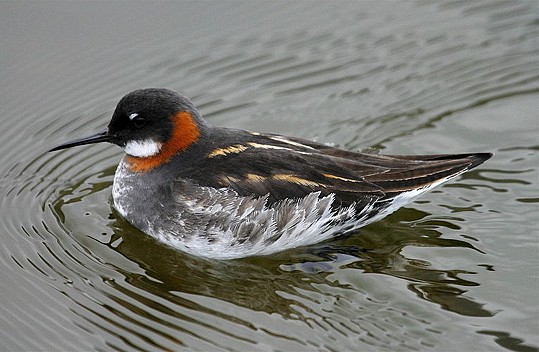
The Red-necked Phalarope, Phalaropus lobatus, is a small wader. This phalarope breeds in the Arctic regions of North America and Eurasia. It is migratory, and, unusually for a wader, winters at sea on tropical oceans. Red-necked Phalarope is about 18 cm (7 in) in length, with lobed toes and a straight, fine bill. The breeding female is predominantly dark grey above, with a chestnut neck and upper breast, black face and white throat. The breeding male is a duller version of the female. They have lobed toes to assist with their swimming. Young birds are grey and brown above, with buff underparts and a black patch through the eye. In winter, the plumage is essentially grey above and white below, but the black eyepatch is always present. They have a sharp call described as a whit or twit.
The typical avian sex roles are reversed in the three phalarope species. Females are larger and more brightly coloured than males. The females pursue males, compete for nesting territory, and will aggressively defend their nests and chosen mates. Once the females lay their eggs, they begin their southward migration, leaving the males to incubate the eggs and look after the young. Three to seven eggs are laid in a ground nest near a marshy area. The young mainly feed themselves and are able to fly within 20 days of birth.
When feeding, a Red-necked Phalarope will often swim in a small, rapid circle, forming a small whirlpool. This behaviour is thought to aid feeding by raising food from the bottom of shallow water. The bird will reach into the center of the vortex with its bill, plucking small insects or crustaceans caught up therein. On the open ocean, they are often found where converging currents produce upwellings. During migration, some flocks stop over on the open waters at the mouth of the Bay of Fundy to take advantage of food stirred up by tidal action.
Almost all of the nonbreeding season is spent in open water. This species is often very tame and approachable. The Red-necked Phalarope is one of the species to which the Agreement on the Conservation of African-Eurasian Migratory Waterbirds (AEWA) applies. The Red-necked Phalorope is a rare and localized breeding species in the British Isles, which lie on the extreme edge of its world range. The most reliable place for them is the Shetland Isles, particularly the Loch of Funzie on Fetlar, with a few birds breeding elsewhere in Scotland in the Outer Hebrides (e.g. at Loch na Muilne, where a "phalarope watchpoint" has been set up) and sometimes the Scottish Mainland in Ross-shire or Sutherland. They have also bred in western Ireland.
Falaropo
di Wilson
Phalaropus tricolor
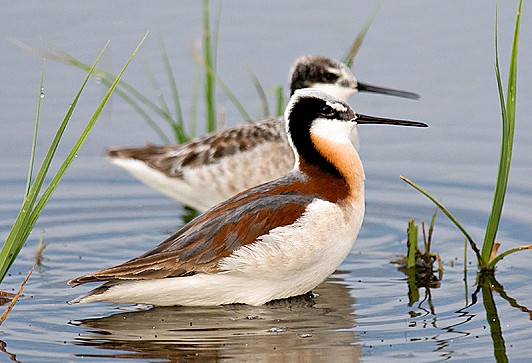
Il falaropo di Wilson (Phalaropus tricolor, Vieillot 1819) è un uccello della famiglia degli Scolopacidae dell'ordine dei Charadriiformes, a volte inserito nel genere monotipico Steganopus. Phalaropus tricolor non ha sottospecie, è monotipico. Questo uccello vive in tutto il Nord e Sud America, nei Caraibi e in Sud Africa, nelle regioni baltiche e in Repubblica Ceca. È di passo nell'Europa centrale, settentrionale e occidentale, in Grecia e Turchia, in Giappone, in Australia e Nuova Zelanda, in Marocco, Namibia, Costa d'Avorio e Oman.
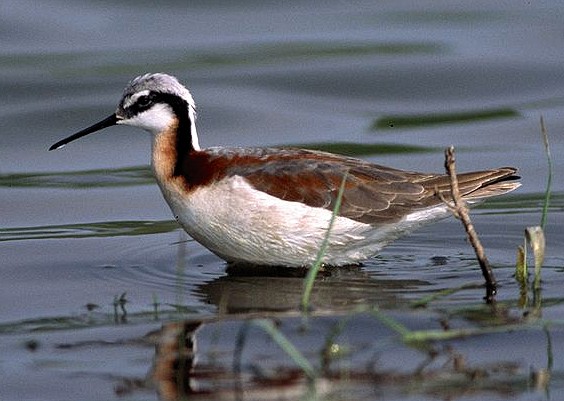
Wilson's
Phalarope
Phalaropus tricolor
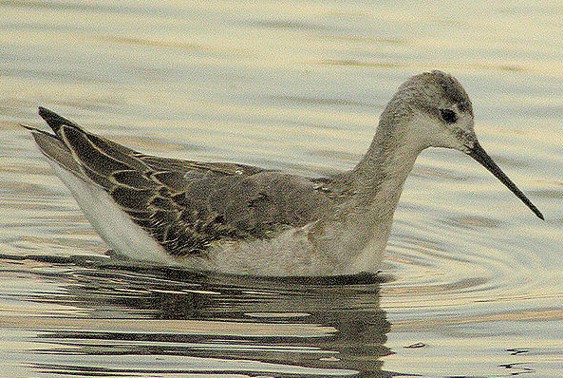
The Wilson's Phalarope, Phalaropus tricolor, is a small wader. This bird, the largest of the phalaropes, breeds in the prairies of North America in western Canada and the western United States. It is migratory, wintering around the central Andes in South America. They are passage migrants through Central America around March/April and again during September/October. The species is a rare vagrant to western Europe. This species is often very tame and approachable. Its common name commemorates the American ornithologist Alexander Wilson. Sometimes, it is placed in a monotypic genus Steganopus.
Wilson's Phalarope is about 23 centimetres (9.1 in) in length, with lobed toes and a straight fine black bill. The breeding female is predominantly gray and brown above, with white underparts, a reddish neck and reddish flank patches. The breeding male is a duller version of the female, with a brown back, and the reddish patches reduced or absent. Young birds are grey and brown above, with whitish underparts and a dark patch through the eye. In winter, the plumage is essentially grey above and white below, but the dark eyepatch is always present.
Wilson's Phalaropes are unusually halophilic (salt-loving) and feed in great numbers when on migration on saline lakes such as Mono Lake in California and the Great Salt Lake of Utah, often with Red-necked Phalaropes. When feeding, a Wilson's Phalarope will often swim in a small, rapid circle, forming a small whirlpool. This behaviour is thought to aid feeding by raising food from the bottom of shallow water. The bird will reach into the outskirts of the vortex with its bill, plucking small insects or crustaceans caught up therein.
The typical avian sex roles are reversed in the three phalarope species. Females are larger and more brightly coloured than males. The females pursue males, compete for nesting territory, and will aggressively defend their nests and chosen mates. Once the females lay their eggs, they begin their southward migration, leaving the males to incubate the eggs. Three to four eggs are laid in a ground nest near water. The young feed themselves. Although very common, this bird's population may have declined in some areas due to the loss of prairie wetland habitat. A few staging areas are of critical importance during migration.